从西方小说中吸血鬼形象的演变看人性的解放和升华
- 格式:doc
- 大小:110.00 KB
- 文档页数:21

解析英美小说中吸血鬼形象的演变陈洁山东中医药高等专科学校摘要:以吸血鬼形象为主题的英美小说由来已久,近年来随着电视剧的改编更是风靡全球。
吸血鬼的形象也从令人惊悚、避而不及摇身变为新生代争相模仿、心生艳羡的偶像,其形象更具时代特色和内涵,成为大众消费的翘楚。
关键词:英美小说;吸血鬼形象;演变一、作家笔下的吸血鬼代表作布莱姆•斯托克通常被认为是近代吸血鬼小说的开山鼻祖,其作品《德拉库拉》[1]讲述东欧吸血鬼之乡—特兰西瓦尼亚—迎来了一位名叫乔纳森的英国年轻律师,他因房地产业务前往该地与德拉库拉伯爵会面。
但不久,乔纳森便发现,这个外貌英俊的伯爵其实是个吸血鬼,而且自己已身陷囹圄,成为侵害对象。
不久,德拉库拉开始引诱露西,她因而梦游墓地,撒手人寰,但她死后也成了德拉库拉的同类,到处嗜食儿童鲜血。
整部小说情节跌宕、诡异,气氛阴森、恐怖,给读者最大的感触就是震悚、愤懑、恐惧、担心。
人们对吸血鬼各种可怕的想象在德拉库拉身上都有所体现。
被誉为“吸血鬼之母”的安妮•赖斯以《吸血鬼编年史》[2]而闻名,“吸血鬼编年史”依次为《夜访吸血鬼》(1976)、《吸血鬼莱斯特》(1985)、《天谴者的女王》(1988)、《肉体窃贼》(1992)、《恶魔迈诺克》(1995)、《吸血鬼阿芒德》(2000)、《血与金》(2001)、《血颂》(2003)。
她的作品之所以能够有恒久的文学价值,靠的并不是打打杀杀、鲜血淋淋。
她的小说以生动描写恐怖情节而又能超越恐怖著称,小说的主题多为历史背景下人的离群索居及对自我的追求,小说中的人物总是现实社会或非现实社会中孤立的群体。
在她书中的吸血鬼不再是只知屠杀的残酷杀手,也不像我国民间传说中青面獠牙的厉鬼形象,他们有七情六欲,有喜怒哀乐,也不乏人性。
安妮笔下的吸血鬼出身高贵、外形漂亮、举止优雅、渴求陪伴,这一系列特征更接近于现实世界中那些游离于主流社会之外的边缘人,鬼的形象逐渐弱化。
《暮光之城》[3]是美国作家斯蒂芬妮•梅尔写的系列小说,包括《暮色》、《新月》、《月食》、《破晓》以及番外《午夜阳光》。


名著吸血鬼读后感恐怖与人性的交织名著《吸血鬼》读后感:恐怖与人性的交织恐惧,作为一种强烈的情绪,往往能够直击人类内心深处。
而当这股恐惧与人性的冲突相遇,足以引发精神上的深层共鸣。
名著《吸血鬼》正是一部将恐怖与人性完美交织在一起的作品。
作为读者,读完这本书后我深深被其中描绘的吸血鬼形象以及人性的扭曲所震撼,同时也对人类内心深处那股未被发掘的黑暗感到忧心。
故事的主角拉菲尔,一个生活在巴黎的贵族吸血鬼,他极富魅力,却道德堕落。
他陶醉在吞噬人类生命的快感中,逐渐迷失自我,也与人性之间的冲突逐渐升级。
他追求永生,却无法摆脱内心的孤独和无尽的恐惧。
通过拉菲尔这一形象,作者布拉姆·斯托克以及一系列后来的吸血鬼小说家所探讨的人性黑暗面得以展现。
恐怖在《吸血鬼》中层出不穷,正所谓“一切恐怖都是自己制造的”。
吸血鬼在黑暗中寻找猎物的过程,以及对猎物的残酷吞噬,都将恐怖感传递给读者。
作者用丰富的描写和扣人心弦的情节,让读者身临其境地感受到恐怖的真实。
阅读时,我不禁产生了一种奇特的心理共鸣,与拉菲尔这个恶魔角色产生了一种莫名的亲近。
也许深层次的恐惧与人性的扭曲是我们每个人都害怕去直面的,而吸血鬼形象的出现,将这种恐怖感象具象化,深深触动着读者内心的恐惧。
然而,正是对恐怖的理解,恐惧才有了反义词——勇气。
在《吸血鬼》中,读者可以清楚地看到人性的种种曲折。
拉菲尔作为一个生活在黑暗中的吸血鬼,对生命的恐惧和对永恒的追求感成了他内心的两重矛盾。
他曾经是一个普通人,有家庭、有亲人,然而命运使他成为了吸血鬼,从此陷入了黑暗无尽的深渊。
拉菲尔虽然表面上拥有力量和不朽,但却永远无法与自己所渴望的幸福相得益彰,这是因为他欠缺的不仅仅是血液,更是对人性和正义的理解。
这一形象给了读者一种思考的机会:人性究竟是善良的,还是恶劣的?当恐怖包围着我们时,我们如何能在黑暗中保持正义的声音?《吸血鬼》以其独特的创作手法和深刻的主题,作为一部伟大的恐怖小说,引导我们思考人性的弱点和黑暗。

拉斯蒂涅《高老头》的拉斯蒂涅是法国王政复辟时期青年野心家的典型,他在人欲横流的社会显示中接受种种人生惨剧的开导,最后埋葬了仅有点的神圣感情,欲火炎炎地投入罪恶的深渊。
拉斯蒂涅是作品中另一个重要人物。
从外省初来巴黎时,他尚有青年人的良心和纯朴观念。
但是,“人生三课”:鲍赛昂子爵夫人“越没有心肝,越高升得快”的告诫,逃犯伏脱冷“要弄大钱,就要大刀阔斧地干”的指点,以及目睹的高老头的悲惨遭遇,使他懂得了金钱的重要性,并且很快适应了新的生活方式,学会了豺狼哲学。
他在埋葬了高老头的同时,也埋葬了“年轻人最后一滴眼泪”,用更加利己主义的手段,向社会发起挑战。
巴尔扎克曾指出:“把一个上流人物,一个野心家,如何抹煞良心,如何走邪路,如何装成伪君子而达到目的,曲曲折折描写下来,说不定一样美,一样的动人心魄。
”在这里,作者成功地塑造了这个“野心家”初出茅庐时的行径,生动地刻画了他的堕落过程拉斯科尔尼科夫《罪与罚》拉斯科尔尼科夫是陀思妥耶夫斯基代表作《罪与罚》中的主人公。
他是一个贫穷的大学生,靠母亲和妹妹打工支持他上学。
由于困顿难支,妹妹决定嫁给富有的中年地主以换取物质支援。
这件事把拉斯科尔尼科夫推到一个道德的十字路口:如果继续上学,就是牺牲亲人的幸福;如果不上学,也对不起家人对他的期望。
他陷入痛苦的思考,认识到在这个世界上,人分为两种:一种人是平凡的,只能逆来顺受,循规蹈矩;一种人是非凡的,是天才和伟人,他‘们可以采取任何行动改变现实,包括杀掉许多人,他想试验一下自己是哪种人,便在一种冲动中杀死了放高利贷的老太婆。
但他却被犯罪感所折磨,陷入极度痛苦,法律、道德、良知从各个方面压迫着他,撕扯着他,将他推向疯狂的边缘。
小说中另一个形象索尼雅,是一切苦难的象征,是美德和自我牺牲的化身,她心灵纯洁、善良,信仰上帝,在痛苦面前坦然、平静。
索尼斯的方式感动了拉斯科尔尼科夫,他在巨大痛苦中接受了索尼雅的劝告,投案自首,用肉体,的痛苦换取心灵的平静。

《德古拉》是布拉姆·斯托克在1897年出版的一部哥特式小说,它不仅开创了吸血鬼文学的先河,而且对后来的流行文化产生了深远的影响。
这部小说以其紧张的情节、丰富的人物和深刻的主题,成为了恐怖文学的经典之作。
首先,这部小说的叙事结构独特而引人入胜。
《德古拉》采用了书信、日记、报纸报道和官方记录等多种文体,构建了一个多视角的叙事世界。
这种结构不仅增加了故事的真实感,也让读者能够从不同的人物视角了解事件的发展,从而更加深入地体验故事的恐怖氛围。
其次,小说中的德古拉伯爵是一个复杂而迷人的反派角色。
他既是一个高贵的贵族,又是一个邪恶的吸血鬼。
德古拉的形象融合了优雅与恐怖,智慧与残忍,这种矛盾性使得他成为了一个难以忘怀的文学形象。
他的存在挑战了人类对生死、善恶的传统认知,引发了读者对于道德边界的思考。
再者,小说中对恐怖和超自然元素的描绘极具感染力。
斯托克通过对德古拉伯爵的描述,以及对吸血鬼传说的细致描绘,创造了一种令人毛骨悚然的恐怖氛围。
这种恐怖不仅仅是外在的,更是心理层面的。
小说中的恐怖元素不仅仅是为了制造惊悚效果,它们也象征着人类内心深处的恐惧和欲望。
此外,这部小说还探讨了性别、阶级和殖民主义等社会问题。
在维多利亚时代的背景下,女性角色如米娜和露西的命运与德古拉伯爵的邪恶力量紧密相连。
这些女性角色的遭遇反映了当时社会对女性的限制和压迫。
同时,德古拉伯爵作为一个来自东欧的贵族,他的形象也隐喻了西方对东方的恐惧和偏见。
最后,这部小说的文学价值在于其深刻的主题和精湛的叙事技巧。
斯托克通过紧张的情节和丰富的人物塑造,探讨了人性的复杂性和道德的相对性。
《德古拉》不仅仅是一部恐怖小说,它也是对人类社会和心理的深刻剖析。
综上所述,《德古拉》是一部值得细细品味的作品。
它不仅是一部关于恐怖和超自然的小说,更是一部关于人性、道德和社会问题的深刻反思。
通过德古拉伯爵的故事,我们被鼓励去探索人类内心深处的恐惧,去思考我们对于善恶、生死的认知。

德古拉小说读后感德古拉,这个名字几乎无人不知。
他是文学史上最著名的吸血鬼,也是布拉姆·斯托克的经典小说《德古拉》的主角。
这本小说被誉为吸血鬼小说的鼻祖,无论是在文学还是电影领域,都产生了深远的影响。
我最近读了这本小说,深深地被其独特的魅力所吸引。
这本小说以日记的形式展开,通过多个人物的视角来叙述故事。
这种叙述方式使得故事更加生动,读者可以通过不同的角度来了解德古拉这个神秘而又可怕的角色。
小说中的人物形象栩栩如生,他们的内心世界和情感变化都被描绘得非常细腻。
尤其是主人公德古拉,他既是一个吸血鬼,又是一个高贵的贵族,他的形象既令人恐惧,又令人着迷。
作者通过对德古拉的描写,展现了他那种独特的魅力和复杂的内心世界,使读者不禁对他产生了一种莫名的同情和理解。
小说中的情节紧凑而又扣人心弦。
从乔纳森·哈克尔的奇遇开始,到德古拉的复仇计划逐渐展开,整个故事充满了悬念和紧张感。
作者巧妙地运用了各种手法,如对话、描写和心理活动等,使得故事更加丰富多彩。
尤其是在德古拉与范·海尔较量的过程中,作者通过对细节的描写和人物的心理刻画,使得读者仿佛置身于故事之中,与角色们一同经历着紧张刺激的情节。
除了情节的吸引力,这本小说还蕴含着深刻的主题和思考。
其中之一就是对人性的探讨。
德古拉是一个吸血鬼,他需要吸取人类的血液来维持生命,但他却同时具有人类的情感和思维能力。
这种矛盾使得他既渴望人类的爱,又无法摆脱吸血的本能。
德古拉的形象既是恐怖的象征,又是对人性的一种反思。
通过对德古拉这个角色的描写,作者探讨了人性的复杂性和矛盾性,引发了读者对自身内心的思考。
此外,小说还涉及到了爱与死亡的主题。
德古拉对米娅的爱是他的动力之一,也是他最大的弱点。
他为了追求爱情,不惜一切代价,甚至放弃了自己的不朽。
爱情使得他变得更加人性化,也使得他更加脆弱。
小说中对爱情的描写既浪漫又悲壮,使得读者对爱与死亡之间的关系产生了深思。

吸血鬼德古拉:恐惧与魅力的并存概述吸血鬼德古拉是文学中一个极具代表性的角色,他既带来了恐惧,又散发着独特的魅力。
本文将探讨吸血鬼德古拉这一角色在文学、电影和流行文化中的重要性,以及他作为一个复杂而引人注目的形象所产生的各种情感和观念。
德古拉的起源吸血鬼德古拉最早出现在布莱姆·斯托克的小说《德古拉》(Dracula) 中。
小说中描绘了一个来自东方的强大吸血鬼形象,他有着逆天长寿和操纵能力,从而使他成为恐怖与邪恶的象征。
文学影响斯托克创作出了一个深具影响力的角色,吸血鬼德古拉迅速成为了文学界甚至是流行文化中最经典且广为人知的怪物形象之一。
他通过诱惑我们内心里那些无可名状的恐惧和欲望,揭示人类的黑暗一面。
电影与吸血鬼的化身自从斯托克的小说出版以来,已经有过多个版本的《吸血鬼德古拉》搬上了大银幕。
这些电影透过各种表现手法,进一步深化了人们对于吸血鬼形象的认知。
其中,尤其值得一提的是1931年由贝拉·卢戈希饰演的电影《德古拉》和1992年由加里·奥德曼主演的弗朗西斯·福特·科波拉导演版本《布拉姆·斯托克特下德古拉》。
魅力与吸引力吸血鬼德古拉的强大力量、永生不老和神秘性使他成为许多人在文学和流行文化中非常热爱的角色。
他那迷人而阴郁的外表以及能够操纵他人思想并获得永恒生命的能力,在某种程度上让他成为一个令人着迷且具有吸引力的存在。
恐惧与救赎虽然在世俗眼中吸血鬼德古拉是恶意的,但他也有着无法抵挡的吸引力。
正因为如此,一些文学作品将德古拉这个角色赋予了复杂的情感。
在某些故事中,德古拉通过与主角发展出纠葛和个人关系,最终得到了某种程度上的救赎。
当代吸血鬼形象吸血鬼德古拉这一形象已经渗透到当代文化中,并且在现代流行文化、电影、电视剧等媒体中仍然占据重要地位。
诸如《吸血鬼日记》、《暮光之城》等系列作品都延续了吸血鬼形象的传统。
结论吸血鬼德古拉既是恐惧源泉,也是一种具有强大影响力和浓烈魅力的存在。

西方艺术作品中吸血鬼形象的文化阐释及其在中国的传播西方艺术作品中吸血鬼形象的文化阐释及其在中国的传播引言在西方文化中,吸血鬼一直被视为神秘、邪恶、具有超自然能力的生物形象。
这一形象广泛出现于西方文艺作品中,包括电影、小说、绘画等。
吸血鬼作为一个文化符号,具有着独特的象征意义和文化内涵。
本文将从西方艺术作品中吸血鬼形象的文化阐释出发,探讨吸血鬼形象在中国的传播以及对中国文化的影响。
一、吸血鬼在西方文化中的象征意义1.1 面对死亡与生命吸血鬼作为不死之物的象征,常与死亡和生命的对立产生联系。
在西方文化中,对死亡的恐惧和对生命的渴望是普遍存在的。
吸血鬼形象将这种对生死的挣扎和思考体现得淋漓尽致。
吸血鬼需要依靠吸取生命力来延续自己的存在,从而成为了永生的象征。
1.2 社会与个体的对立吸血鬼形象也常被用来描绘社会与个体之间的冲突。
在吸血鬼的世界中,他们常常被视为社会的异类,被迫独居或者形成小团体生活。
他们与正常人类的关系往往是对立的,有着不可逾越的鸿沟。
吸血鬼形象通过这种对立关系,表达了对社会价值观和道德规范的批判。
1.3 欲望与自我控制吸血鬼形象中也带有对欲望和自我控制的思考。
吸血鬼需要吸取鲜血来维持自身生存,但对于某些吸血鬼而言,他们能够控制自己的欲望,只吸取适量的鲜血。
这种自我控制的能力与抑制欲望之间的矛盾,体现了人性中的智慧和困惑。
二、吸血鬼形象在中国的传播2.1 文学作品中的传播吸血鬼形象最早通过西方文学作品传入中国。
19世纪末,布拉姆·斯托克的小说《吸血鬼》被引入中国,推动了吸血鬼形象在中国文学领域的传播。
《吸血鬼》的故事情节和吸血鬼形象给了中国文学创作者很多灵感,如金庸的武侠小说《神雕侠侣》中便加入了吸血鬼元素,形成了中国特色的吸血鬼形象。
2.2 电影与电视剧的传播吸血鬼主题的电影和电视剧也在中国取得了广泛的传播。
20世纪80年代,美国电影《暮光之城》的推出在中国引起了轰动,吸引了大量的年轻观众。

德拉库拉读后感导语:德拉库拉读后感(一)《德拉库拉》是爱尔兰作家 B.斯托克写的一部长篇小说。
它的全文都是以书信和日记的形式,讲述关于德拉库拉伯爵,一个邪-恶的吸血鬼的故事。
德拉库拉伯爵是一个靠吸食人类血液而在世上生存长达数百年的邪-恶吸血鬼。
他为了能够找到更多的“猎物”,打算把自己的家移到英国。
而当这个计划被主人公约翰,阿特公爵,昆西博士和米纳发现后,他们便开始寻找方法消灭这个拥有不死之身和各种恐怖能力的妖怪。
《德拉库拉》虽然是在写各种离奇的灵异事件,但我们从中能够看出大量现实生活的投影,现实中人物在各种状态下的心理,和作者对待这些事情的态度。
例如,当阿特公爵原本善良的未婚妻露西成为德拉库拉的猎物,然后在众目睽睽之下变成和德拉库拉一样冷酷无情的吸血鬼的时候,作者很细致地描写了每个人的内心斗争。
他写出了唯一的知情人士昆西在告诉同伴事实时苦涩抉择的挣扎,写出了米纳面对最好的朋友变坏的事时所透露出来的勇敢与坚强,还写出了阿特公爵必须亲手杀死自己未婚妻时的痛苦与绝望。
这些描写都是他们本人通过语言表达出来,以及我们对于他们如何运用语言的分析分析出来的。
能够仅仅通过语言把一个人描写得栩栩如生,是强,而能让我们透过自己对于人物语言的分析,再得出进一步更深刻的理解,那只能说是绝了。
我只能说,斯托克真是一个文学天才。
而且他的天才不仅是体现于语言运用的描写上。
他所表达出的思想,虽然简单,给人留下的印象却异常深刻。
德拉库拉凭借自己作为吸血鬼拥有的各种神力,行恶数百年,一直都没有人干扰,所以他以为自己天下无敌,心中充满了自负与骄傲。
但他所不知道的是,在民间早就有了一个地下组织在追踪他,查阅他的消息,并且寻找消灭它的方法。
这个组织的存在,可以追踪到几百年前,德拉库拉刚刚出世作恶的时候。
虽然线索不多,但几百年下来所积累的各种证据,使得他们的后代昆西找出了消灭邪-恶的吸血鬼伯爵的方法,利用伯爵的弱点,他的骄傲,最终根除了这个祸害。

吸血鬼:欲望的诱惑与人性的黑暗概述吸血鬼是一种神秘而令人着迷的生物,作为文化和文学中经常出现的主题之一,它们往往以其特有的能力和永生状态引发人们的无尽好奇。
在各个世纪和不同文化中,吸血鬼都被赋予了特定的特征和传说。
本文将探讨吸血鬼形象背后隐藏的欲望诱惑和人性的黑暗面。
起源与历史吸血鬼的起源可以追溯到古代神话和传说,如巴比伦、古希腊及罗马等文明。
吸血鬼形象在18世纪至19世纪初的东欧民间传说中得到了广泛流传,并在布拉姆·斯托克尔(Bram Stoker)于1897年出版的小说《吸血鬼》中成为了一个复杂而令人畏惧的角色。
吸血鬼形象及特点吸血鬼通常被描绘成夜间活动并依靠吮食他人鲜血来维持生命的不死生物。
它们具有独特的特征,如尖牙、能力操纵心理和体能等。
吸血鬼也被认为是邪恶和邪门力量的象征,往往与黑暗和死亡联系在一起。
欲望的诱惑吸血鬼的存在常常与欲望的诱惑密切相关。
它们通过吸取他人的生命能量来延长自己的寿命,这种欲望追求永恒存在成为了其驱使力。
同时,吸血鬼还以其美貌和魅力迷惑人类,在沉沦其中无法自拔。
人性的黑暗面吸血鬼形象在文学作品中几乎总是与人性的黑暗面相联系。
它们曾经是普通人类,但因某种原因转化为吸血鬼。
这个变化过程揭示了人性中难以抑制的渴望、贪婪和堕落等阴暗情感,同时也探讨了道德边界和后果。
文学与电影影响从《吸血鬼》到现代作品如《暮光之城》和《真爱至上》,吸血鬼主题一直在文学和电影中占据重要地位。
吸血鬼形象的塑造以及对欲望和人性的探索,对于现代文化产生了深远的影响。
总结吸血鬼作为一个富有诱惑力和复杂性的形象,在文学和影视作品中一直备受瞩目,并成为了人们讨论欲望、人性阴暗面以及道德边界等问题的重要角色。
通过深入探讨吸血鬼的特点与意义,我们可以更好地理解和审视人类内心纷争,以及永恒的诱惑与黑暗隐藏在每个人之中。

《夜访吸血鬼》中吸血鬼形象文化意蕴及人性演变作者:谢欣欣来源:《文学教育·中旬版》2013年第11期[摘要] 《夜访吸血鬼》是美国作家安妮·赖斯的代表性作品,创作于1976年,是其《吸血鬼编年史》系列小说中的第一部,它颠覆了吸血鬼恶魔般的传统形象,并从多个视角诠释了吸血鬼的新形象。
安妮借助小说中吸血鬼的迷茫与困顿,反映了现实社会中人性的困惑、人与自己以及人与社会的矛盾,具有超越现实的哲学意蕴。
[关键词] 吸血鬼;人性一提到吸血鬼,人们总会自然而然地联想到恐怖和血腥,它们没有情感,也没有人性,以杀人为乐,让人不寒而栗,然而安妮笔下的吸血鬼却是让人爱恨交加。
它们以吸血为生,却也渴望着与人类为伍;它们苦苦地追寻自我,追求美好,却始终找不到归属;它们拥有着超于常人的神力,却依然受到死亡的威胁。
安妮·赖斯运用幻想的手法,呈现给读者一个非现实的世界。
《夜访吸血鬼》这部作品反映了人性的困惑、人与自己以及人与社会的矛盾,是社会现实的投影,更具有超越现实的哲学意蕴。
一、吸血鬼的传统文化历史上,不同种族和区域的人们在世界的不同角落创造了许多在暗夜里活动的角色,如幽灵、僵尸和狼人等。
吸血鬼是其中独具特色的一种,与幽灵相比,有着人一样的肉体;与僵尸相比,有着僵尸所不具备的独立思想和社会体系;与狼人相比,有着不同于狼人在月圆之夜才能变身的限制。
吸血鬼文化属于欧洲传统文化的范围,负载着欧洲古老的文明,在西方文化中具有深厚的历史背景。
在西方文化传统中,“吸血鬼主题集疾病、死亡、性和宗教情感等几大强有力的主题于一身”,它们不仅仅是被塑造出的一个形象,而且是一个文化体系,有自己的起源、历史、等级等等,可以说几乎所有的吸血鬼形象都是在这一框架中衍生出来的。
安妮·赖斯在《夜访吸血鬼》中虽然用“架空史学”的手法颠覆了一些传统的吸血鬼文化,但我们不能否认吸血鬼的传统文化对她的文学创作仍具有极大的影响。
安赖斯的《夜访吸血鬼》中吸血鬼形象分析一、本文概述《夜访吸血鬼》是美国作家安妮·赖斯(Anne Rice)的代表作之一,也是吸血鬼文学的经典之作。
这部作品以独特的视角和细腻的笔触,展现了吸血鬼世界中的爱恨情仇、悲欢离合。
本文旨在深入分析《夜访吸血鬼》中的吸血鬼形象,探讨吸血鬼作为文学角色所承载的深层含义和文化内涵。
通过对吸血鬼形象的解析,我们能够更好地理解这部作品的艺术价值和社会意义,同时也能够洞察人类内心深处对于永生、孤独、爱与自由的渴望与恐惧。
在《夜访吸血鬼》中,吸血鬼不仅仅是传统意义上的恐怖怪物,更是具有复杂情感和思想的生命体。
他们有着自己的社会结构、价值观和生活方式,与人类世界既相互独立又相互交织。
吸血鬼形象的塑造,既体现了安妮·赖斯对于超自然元素的独特想象,也反映了她对于人性、生命和存在意义的深刻思考。
通过对这些吸血鬼形象的细致分析,我们可以感受到作家对于生命终极意义的探索和对人性复杂面的洞察。
二、吸血鬼形象的演变在文学和影视作品中,吸血鬼的形象随着时间和文化背景的变化而不断演变。
从最初的恐怖、邪恶、被社会排斥的存在,到后来的神秘、优雅、甚至有些魅力的角色,吸血鬼的形象经历了深刻的转变。
在安赖斯的《夜访吸血鬼》中,这种转变得到了进一步的体现。
在早期的吸血鬼传说中,吸血鬼通常被描绘为面目可憎、身体腐烂、行为残忍的怪物。
他们通过吸取他人的血液来获得永生,但同时也因此被诅咒,永远无法在阳光下生活,只能在夜晚出没。
这种形象体现了人们对死亡和未知的恐惧,以及对生命的渴望和对衰老的抗拒。
然而,在《夜访吸血鬼》中,吸血鬼的形象被赋予了新的内涵。
安赖斯笔下的吸血鬼不再是令人恐惧的怪物,而是变成了优雅、神秘、甚至有些魅力的存在。
他们有着自己的社会结构和行为准则,有着复杂的情感和人际关系。
他们不再是单纯的吸血者,而是变成了有着深刻内心世界和复杂人性的角色。
这种转变反映了社会对于吸血鬼文化的接受和改造。
德古拉小说读后感提到吸血鬼,相信很多人的脑海中都会浮现出德古拉的形象。
最近,我读了有关德古拉的小说,真的是被深深吸引,那种感觉就像是掉进了一个神秘又刺激的世界,半天都没缓过神来。
在这本小说里,德古拉的形象被刻画得极为深刻。
他可不是那种简单的、只会张牙舞爪吓人的怪物。
作者用细腻的笔触为我们描绘了一个充满魅力,却又让人毛骨悚然的吸血鬼伯爵。
他优雅、聪明,有着高贵的气质,但同时又残忍、冷酷,为了满足自己的欲望不择手段。
记得有一个情节,德古拉在夜晚悄悄潜入一位少女的房间。
那房间安静得只能听到少女平稳的呼吸声和德古拉轻微的脚步声。
德古拉就像一个幽灵,无声无息地靠近床边。
他的身影在月光的映衬下显得格外修长,黑色的斗篷随风微微摆动。
他俯身看着熟睡中的少女,眼神中透露出贪婪和渴望。
他的牙齿在黑暗中闪着寒光,仿佛迫不及待地想要咬开少女那白皙的脖颈,品尝那温热的鲜血。
作者对这个场景的描写简直太细致了,让我感觉自己就站在那个房间的角落里,亲眼目睹着这一切。
我的心都提到了嗓子眼,紧张得手心里全是汗,真怕德古拉下一秒就发现我,然后把我也变成他的猎物。
还有一处让我印象特别深刻的,是德古拉和那些追踪他的人的斗智斗勇。
他总是能巧妙地避开追踪,消失得无影无踪。
有一次,追踪者们以为已经把他逼到了绝境,一个废弃的古堡。
那古堡阴森恐怖,墙壁上爬满了青苔,风一吹,发出呜呜的声音,好像在诉说着过去的悲惨故事。
追踪者们小心翼翼地走进古堡,手中的火把照亮了黑暗的角落。
他们的脚步声在空旷的大厅里回荡,显得格外响亮。
然而,德古拉却像是会隐身一样,怎么也找不到。
就在他们稍微放松警惕的时候,德古拉突然从黑暗中冲了出来,速度快得让人根本来不及反应。
他的笑声在古堡中回荡,那是一种充满嘲讽和得意的笑。
我读着这些情节,仿佛自己也跟着追踪者们一起经历了这场惊心动魄的冒险。
我能感受到他们的紧张、恐惧和不甘心。
也正是这种强烈的代入感,让我对这本小说欲罢不能。
除了紧张刺激的情节,小说中对于人性的刻画也让我深思。
解析西方小说中的吸血鬼形象及其现实意义作者:程东岳潘纯来源:《赤峰学院学报·哲学社会科学版》2015年第08期摘要:以吸血鬼为主题的西方文学作品由来已久,近年来又广为流行。
吸血鬼形象在这些文学作品中经历了种种变化,与时代同步。
本文在近现代几部具有典型代表性的吸血鬼题材小说的几个代表作品的基础上分析了吸血鬼的形象及其变化,并讨论了这些变化背后折射出来的社会现实意义。
关键词:吸血鬼;吸血鬼形象;西方文学中图分类号:I106.4 文献标识码:A 文章编号:1673-2596(2015)08-0190-03一、引言吸血鬼题材的文学作品在西方的渊源可追溯到18世纪欧洲神秘而恐怖的哥特式小说。
早在19世纪初英国诗人济慈和拜伦在他们的诗歌中就有对吸血鬼形象的描述,爱尔兰小说家布莱姆·斯托克(Bram Stoker)被认为是近代吸血鬼文学的开山鼻祖,他于1897年所出版的小说《吸血鬼德拉库拉》(Dracula)中塑造的吸血鬼德拉库拉伯爵形象被认为是吸血鬼的起源之一。
被誉为“吸血鬼之母”的美国女作家安妮·赖斯(Anne Rice)自1976年开始所创作的关于吸血鬼家族史的系列小说《吸血鬼编年史》(The Vampire Chronicles)则颠覆了传统吸血鬼的形象而赋予了吸血鬼家族新的形象,引起读者的强烈反响。
近年来吸血鬼文学的风靡又掀起了吸血鬼文化的流行,如美国女作家L.J.史密斯(L. J. Smith)创作的《吸血鬼日记》(The Vampire Diaries)和斯蒂芬妮·梅尔(Stephenie Meyer)的《暮光之城》(The Twilight Saga)代表了吸血鬼文学新的走向。
本文将在以上具有代表性的吸血鬼小说的基础上分析这些作品中的主要吸血鬼形象及其映射出来的社会现实意义。
二、代表小说中的吸血鬼形象(一)《德拉库拉》《德拉库拉》被认为是近代吸血鬼小说的开山之作,作者布莱姆·斯托克以书信体的方式讲述了一个年轻的律师乔纳森发现了居住在神秘古堡中外表具有绅士风度的德拉库拉伯爵实际上是一个吸血鬼,专门引诱年轻貌美的女子,但最后被众人消灭的故事。
《吸血鬼系列》读后感
《吸血鬼系列》是一部让人着迷的小说系列,它深刻地探讨了人性的复杂性和
欲望的无穷深度。
在这个充满神秘和黑暗的世界里,吸血鬼们的存在让人不禁思考生命的意义和道德的边界。
整个系列的故事情节紧凑,扣人心弦,每一个角色都有着独特的魅力和深刻的
内心世界。
主人公艾丽丝的坚韧和勇气,爱德华的深情和忠诚,雅各布的热情和坚持,每一个人物都让人难以忘怀。
作者通过这些角色的命运交织,展现了人类的善良与邪恶,渴望与绝望,让读者在其中感受到生命的无常和命运的无奈。
在这个充满幻想和超自然力量的世界里,作者巧妙地融入了对现实社会的批判
和反思。
吸血鬼们虽然拥有永生的力量,却也承受着孤独和痛苦。
他们的存在让人们思考生命的意义和目的,以及人类对权力和欲望的追求。
通过吸血鬼们的故事,作者揭示了人类内心的黑暗面和欲望的无穷深度,让读者反思自己的生活和选择。
在整个系列的阅读过程中,我深深被作者的想象力和文笔所吸引。
她用细腻的
笔触描绘了每一个角色的内心世界,让人感受到他们的痛苦和欢乐。
故事情节跌宕起伏,扣人心弦,让人无法放下。
作者通过对吸血鬼们的探讨,引发了我对生命、爱情、友情和信仰的思考,让我重新审视自己的生活和选择。
总的来说,读完《吸血鬼系列》让我深深陶醉在这个充满神秘和黑暗的世界里,让我感受到人类内心的复杂和多样性。
这部小说系列不仅是一部优秀的幻想小说,更是一部引人深思的文学作品。
通过吸血鬼们的故事,作者揭示了人类内心的黑暗面和欲望的无穷深度,让我对生命和人性有了更深刻的认识。
希望大家也能够阅读这部小说系列,感受其中的魅力和深度。
On the Emancipation and Sublimation of Humanism in the Evolution ofV ampire in Western Fictions从西方小说中吸血鬼形象的演变看人性的解放和升华AbstractIn western world, the legend of vampire has been in existence since the birth of history. After that, literature and movies on vampires are enduring and prosperous through centuries. Vampire culture plays an important role in the western mass cultural traditions, and has great influence on them. One of the most well-known products is the fiction Dracula (1897) written by Ireland author Bram Stoke at the end of 19th century. There are over 100 adaptations which are based on the fiction. Therefore, Stoke is regarded as the founder of vampire fictions and the image of Dracula dominates in people’s mind as the authoritative and prototypical image of vampires. Nevertheless, Anne Rice, an American contemporary writer, wrote The Vampire Chronicles at the end of 20th century, which is called the Bible of vampires by vampire fans and vampire researchers. She overthrows the traditional rigid figure of the vampire, reveals the truth of realistic world by describing unrealistic world, digs arcanum of the deep human nature from vampires’inner being, and then reflects certain layers of the existent state. It is undeniable that Rice has inherited and also revolutionized the image of the vampire in Dracula.By comparing and analyzing the difference between the image and feature of the two group of vampires, we can find that every age does indeed seem to embrace “the vampire that it needs‖ (Gordon and Hollinger, 1997: 1), because each of them reflects the culture of their age to a large extent. And by examining the evolution of vampires, we can grasp the emancipation and sublimation of humanism in the two centuries. As the two works are representative and influential at each age, this thesis here interprets and analyzes the transformation of their cultural backgrounds to present the development of humanism in western society from 19th century to 20th century.Key words: vampire;humanism;comparison;culture;evolution摘要在西方世界,关于吸血鬼的传说有史以来便存在。
之后,以吸血鬼为题材的文学和电影便经久不衰,几个世纪以来仍欣欣向荣。
吸血鬼文化在西方大众文化传统中占据着举足轻重的地位,并对之有不可小觑的影响力。
爱尔兰19世纪末作家布兰姆·斯托克于1897年所著的小说《德库拉》是其中最著名的作品之一。
之后大约有100多部基于该小说所作的改写本。
斯托克因此被公认为吸血鬼小说的奠基者,而德库拉的形象也因此扎根于读者的头脑中成为吸血鬼的原型。
20世纪末,美国当代作家安妮·赖斯,撰写了一部恢宏的系列小说《吸血鬼编年史》,它被吸血鬼爱好者和专家誉为“吸血鬼的圣经”。
安妮推翻了吸血鬼传统和刻板的形象,通过描绘一个虚幻的世界挖掘出真实世界的真相,从吸血鬼的内心世界探索人性深处的奥秘,并反映出了人类现存状态的某些层面。
难以否认的是,安妮继承并且改革了《德库拉》中的吸血鬼形象。
通过对比和分析两部吸血鬼作品所塑造的吸血鬼形象和特征的不同,我们可以发现似乎每个时代都在创造着“它所需要的吸血鬼”(Gordon and Hollinger, 1997:1),因为每一部作品都在很大程度上反应了它所处时代的文化。
通过分析吸血鬼的发展变化,我们能看到一百年来西方社会人性的解放和升华。
由于那两部作品在各自时代中都相当具有代表性和影响力,因此这篇论文便通过分析和解读两部作品中的文化背景的演变以展示西方社会从19世纪至20世纪人文主义的发展。
关键词:吸血鬼; 人文主义;人性;比较法;文化;演变IntroductionV ampires are popular figures, often appearing in Gothic fiction of the eighteenth and nineteenth centuries. Among them, the most influential work at that time is Bram Stoker’s Dracula at the end of 19th century. The prime characteristic of his vampires is that they are mostly portrayed as monsters. They are nothing but a bloodthirsty killer. Opposing the monster there is always a hero or even a group of heroes who, at the end, will succeed in annihilating the fiend and saving humanity. An explicit separation exists between vampires and humans. The reader will identify with the human hero and feel completely detached from the monster that, along with its horrific characteristics, inhabits remote and ghastly locations.The resurgent vampire fiction of the late twentieth century presents us with a different image. Contemporary authors place ―increasing emphasis on the positive aspects of the vampire’s eroticism and on his or her right to rebel against the stifling constraints of society‖(Seaf, 1988:163). More and more authors explored a more natural, rather the supernatural vampire (I am Legend, Richard Matheson), or a vampire hero. The most typical work of this kind is Anna Rice’s The Vampire Chronicles at the end of 20th century.V ampires have transformed from their late nineteenth-century signification as monstrous Others into largely sympathetic characters. This literary domestication presents us a shift of human’s perspective from which they go to approach and understand the figure of vampire. And this shift reflects a humanism development and sublimation in the western culture. This thesis aims to explore the cultural background behind the image of vampires in Dracula and The Vampire Chronicles respectively and by examining the transformation of vampires it presents the process of emancipation and sublimation of humanism in western culture from the 19th century to 20th century.This thesis starts from a brief introduction to the vampire. The second chapter explores the image of vampires in Dracula and its Victorian culture overtone. The third chapter focuses on the interpretation of the transformational characteristics ofvampire sin in The Vampire Chronicles and examine how and in what ways this particular popular vampire character may reveal symbolically aspects of the hidden nature in contemporary western society. The last chapter compares the differences between the two representative images of vampires and explores the transformation and evolution of humanism theme in western culture. The thesis ends with a conclusion –the evolution of vampires in western fictions is a process of the emancipation and sublimation of humanism in western culture.Chapter One Brief Introduction to the V ampire1.1 Folk beliefsThe notion of vampirism has existed for millennia; cultures such as the Mesopotamians, Hebrews, Ancient Greeks, and Romans had tales of demons and spirits which are considered precursors to modern vampires. However, despite the occurrence of vampire-like creatures in these ancient civilizations, the folklore for the entity we know today as the vampire originates almost exclusively from early 18th century Southeastern Europe, when verbal traditions of many ethnic groups of the region were recorded and published. In most cases, vampires are revenants of evil beings, suicide victims, or witches, but they can also be created by a malevolent spirit possessing a corpse or by being bitten by a vampire. Belief in such legends became so pervasive that in some areas it caused mass hysteria and even public executions of people believed to be vampires.1.2 Description and common attributesIt is difficult to make a single, definitive description of the folkloric vampire, though there are several elements common to many European legends. V ampires were usually reported as bloated in appearance, and ruddy, purplish, or dark in color; these characteristics were often attributed to the recent drinking of blood. Indeed, blood was often seen seeping from the mouth and nose when one was seen in its shroud or coffin and its left eye was often open. It would be clad in the linen shroud it was buried in, and its teeth, hair, and nails may have grown somewhat, though in general fangs were not a feature.Chapter TwoThe Attributes of Dracula and Its Victorian Culture Overtones 2.1The image building of Dracula and its attributes2.1.1 Its appearance and attributesThe fiction gives a vivid and detailed description of the appearance of vampire Dracula: Dracula's face was a strong - a very strong - aquiline, with high bridge of the thin nose and peculiarly arched nostrils; with lofty domed forehead, and hair growing scantily round the temples, but profusely elsewhere. His eyebrows were very massive, almost meeting over the nose, and with bushy hair that seemed to curl in its own profusion. The mouth, so far as I could see it under the heavy moustache, was fixed and rather cruel looking, with peculiarly sharp white teeth; these protruded over the lips, whose remarkable ruddiness showed astonishing vitality in a man of his years. For the rest, his ears were pale and at the tops extremely pointed; the chin was broad and strong, and the cheeks firm though thin. The general effect was one of extraordinary pallor.(Jonathan Harker's Journal, Dracula, Chapter 2)Their residence mostly is a dilapidated castle built on the top of a remote mountain, filled with rats, bats and spiders. They sleep in a coffin with mud and dirt on it. At night, they rise from the coffin to suck the blood of sleeping people.In Dracula, vampire is such a cruel and disgusting monster who is only a reanimated corpse without soul and emotion. They are evil and appalling, and stand an opposite position against human being. They belong to the long dark night and are afraid of sunlight. They aim to destroy human being and rebuilt a world under their command and order.In this novel, vampire is associated with cold, death, horror, darkness, wickedness and sin.2.1.2The narrative mode of vampire’s image--buildingDracula is an epistolary novel, written as a collection of diary entries, telegrams, and letters from the characters, as well as fictional clippings from theWhitby and London newspapers and phonograph cylinders. This literary style adds a sense of realism and provides the reader with the perspective of most of the major characters. By use of the epistolary structure, Stoker, without employing either an omniscient narrator or any awkward framing device, maximizes suspense by avoiding any implicit promise to the reader that any first-person narrator must survive all of the story's perils. Nevertheless, this narrative mode avoids any descriptions about vampires’inner world or thoughts, thus readers have no idea of what they think and their emotions, if they have any.The novel puts vampires in a remote and defamliar position who are totally alien and incomprehensible. The attitudes people take towards vampires are detached and hostile. That is all the narrative mode creates. And a strong feeling of hatred against vampires prevails the whole novel.2.2Its Victorian culture overtones2.2.1Religion overtoneThe novel saturates itself with a strong sense of religion. In it, the vampire is the embodiment of Satan, the foe of God. It represents all the evilness, fall, and moral depravation. V ampire plays the role of a villain, and it is a common scene in the novel that a churchman holds the bible and the cross to destroy vampire, and in the end, it is the victory of Christianity over the vampire, the paganism.It is known that in the year of 1897, Queen Victoria witnessed her Diamond Jubilee, and her son and successor was only a fatuous playboy. In a period of political riots and a reign of chaos, the revolutionary enthusiasm brought by the French Revolution only to add insult to injury. In order to keep the prosperity and stability of the empire, the authorities need to repress any kind of invasion from alien races and religions. Dracula, as a vampire of Transylvanian origin, implies an alien and a pagan. The common destiny of vampires is to be exiled and abandoned, which can be easily associated with the destiny of those aliens and pagans at a time of imperialism and xenophobia. The cruel slaughter of Dracula in that novel to some extent reflects the merciless repression of the paganism at that time. And from that readers can get a glimpse of the severe religious conflicts between Christianity and paganism, and alsothe brutal and inhuman suppression.2.2.2Morality overtone: good vs. evil, light vs. darkness--survive orperishAn intense conflict between vampires and human beings is that they can not coexist. V ampires have to kill human beings to survive and human beings vice versa. Clearly, vampires are the speaker of evil and darkness, while human beings of good and light. V an Helsing, a character in the novel who kills Dracula in the end proves that good can always defeat evil.A simple moral duality exists and each of which takes an opposite end without compromise and reconciliation. Dracula and V an Helsing, each belongs to darkness and light, are fated to fight each other to survive, and the final victory of V an Helsing tells that evil is doomed to fail. All of these imply that the moral system of Victorian society is dual, strict, extreme and cruel.2.2.3Sexuality overtoneIn the novel, Dracula is a typical demon gathering all kinds of sins, among which is a ―dark desire‖, i.e., the lust for sexuality. Some critics say that the novel is somewhat crude and sensational, and the sexual longings underlying the vampire attacks are manifest. As one critic wrote:What has become clearer and clearer, particularly in the fin de siècle years of the twentieth century, is that the novel's power has its source in the sexual implications of the blood exchange between the vampire and his victims...Dracula has embedded in it a very disturbing psychosexual allegory whose meaning I am not sure Stoker entirely understood: that there is a demonic force at work in the world whose intent is to eroticize women. In Dracula we see how that force transforms Lucy Westenra, a beautiful nineteen-year-old virgin, into a shameless slut.(Leonard Wolf, "Introduction" to the Signet Classic Edition, 1992)Dracula represents the strong desire to monopolize and the liberation of women’s sexual desire. His kiss of death symbolizes male’s possessive desire to female. In the meantime, female also get lots of satisfaction with their sexual demand in that process. This wicked breakthrough, brought by Dracula, of the tradition thatfemale is not in a position to be satisfied but to satisfy the male during the sexual relationship, is horrible to the Victorian people.Lucy’s death and Mina’s salvation in the novel also reflect Victorian norms about women. Lucy is beautiful and innocent, but also conceited and ignorant. She juggles three men at the same time and doesn’t know who to choose. She vexes: ―Why can’t they let a girl marry three men, or as many as want her.‖(Chapter 5); she is totally ignorant of the danger that approaches her, let alone death: ―There was a sort of scratching or flapping at the window. But I did not mind it.‖(Chapter 9) In contrast, Mina, who gives first priority to husband’s career, earns many compliments from V an Helsing ―so clever woman‖, ―believe me that I came here full of respect for you, and you give me hope…!‖ (Chapter 14) In comparison, it is easy to find that, according to the traditional ethical and moral standards, Lucy represents depravation and ignorance, while Mina embodies intelligence and braveness and she sets a good model for Lucy, and for all other women. Lucy fails to resist Dracula’s enticement and is finally drained to the point of death; while Mina, resisting Dracula’s powerful temptation with the strength and discipline of strict traditional female ethics finally survives. Here, as a matter of fact, the writer punishes those licentious women who violate the female ethics and indulge in sex in the name of Dracula, from which, we can see the sexual constrain on women in Victorian times. That is because, to the author living in the late Victorian times, sexuality is usually associated with bestiality, pollution, filth, evil, crazy, lowliness and death. But to the women, the dark kiss of Dracula is what they pine for. So ―Dracula‖, in this sense, is a symbol of human’s self denial of their inner sexual desire.Chapter ThreeThe Attributes of V ampire by Anna Rice and ItsContemporary Culture Overtones3.1 The image building of vampire and its attributes3.1.1 Its appearance and attributes: counter-traditionIt’s undeniable that The Vampire Chronicles by Anne Rice has revolutionized the image of vampire. Firstly, all the vampires in it are handsome and gorgeous, look like angels in the Bible, and are fascinating to human beings. Lestat, a vampire in it, is a blond and elegant up-class gentleman; Louis de Point, another vampire, is compared to Wilde, a writer in the decadence period in the late 19th century. Lewis has dark-colored curls, and is handsome, graceful and also gentlemanlike. Claudia, a girl vampire, is a beautiful and intelligent child who looks like a princess. All of these transformations on appearance has added a luster to vampire’s image and reduced its horror effect.On top of that, Rice’s vampires still live on human being’s blood, which is the same as Dracula, yet it is out of their instinct biological need but not to create any terror as Dracula does. They seclude themselves from outside world and cover their true identity in the hope of avoiding attack from human beings, while Dracula conceals his vampire identity to wait for his chance to conquer human beings. As a result, the holy water, the cross and the mantra have no threatening effect to them but are lethal to Dracula.Last and the most important is that all these vampires of Anne Rice have been endowed with a rich inner world and distinct personality. They have affections and desires, love and hates. They may fall in love desperately with someone. Love, the most invaluable emotion in humanity still remains in them. It’s this touch of humanity that gets them rid of the unicity of a monster.In this novel, different from the detestable, monstrous and low vampires in Dracula, the vampires here are depicted as noble and emotional beings.3.1.2 Narrative mode of vampire’s image--buildingInterview with the Vampire, a famous volume of The Vampire Chronicles, will be taken as a sample for my analysis.For an author, it’s one of the most important choices she or he makes about telling the story. A first-person narrator puts the reader into the action but requires that the author report all events from the narrator’s experience and in the narrator’s voice.A third-person limited narrator distances the reader from the story,but allows the author more freedom to use a more authoritative voice and to make more detailed descriptions of actions and their meanings. In Interview with the Vampire, Anne Rice had a tough point-of-view choice to make. She wanted to tell the story of the intense emotional longings of a moral being after hundred years as a vampire. Louis’s story was not interesting to Rice simply because he sucked blood to survive. What fascinated Rice about the character of Louis was that after all those years as in immortal, he still retained his humanity and still anguished over what he had become. Given her interest in Louis’s psychology and inner torment, first-person point of view would seem to be Rice’s logical choice because it would put the reader in Louis’s mind to suffer the torment with him, to regard Louis as the familiar. But Rice also wanted the reader to feel the seductive pull of the vampire, to see him as the Other, the unfamiliar, someone who is different from the ―normal‖ people in society, a tragic outcast, inhuman and beautiful. To do that, she needed the distance of a third-person observer-narrator. A third-person narrator who was a ―normal‖ person could see and describe not only the alluring way Louis looked and moved, but also the emotional pull of his story on those he met. In other words, Rice needed to show both points of view so that the reader understood the agony of being a vampire completely and yet was as drawn to it a the interviewer in the story. Needing both, Rice chose to have her delicate shift from the third person point of view to the first person point of view.The beginning of the story is told in the third-person observer point of view through the eyes of the young man who has asked to interview the vampire. This interviewer is like the reader in every way, ignorant of the ways of the vampire, fascinated by and fearful of the dark figure before him, and finally seduced into the lure of the Other. As the interviewer observes Louis’s agony form a distance, thevampire becomes a real physical presence, and the reader listens and is seduced into the vampire’s story along with the interviewer. But the interviewer’s role in the story—and the story that the interviewer actually takes part in—is only a fraction of Interview with the Vampire. The majority of the story is Louis’s, and he tells it to the interviewer as a first-person narrator. That is, most of this story is Louis telling his story using ―I‖ as his pronoun. This means that the reader gets to participate in Louis’s agony, becoming one with Louis as the ―I‖narrator. So Rice has surrounded Louis’s intimate first-person story with the interviewer’s distant third-person limited-observer frame story, thereby getting the benefits of both points of view. By combining the two narrative modes Rice arouses readers’ sympathy with and understandings of vampires.3.2 Its contemporary culture overtonesRice’s vampire is mobile enough to touch a range of contemporary issues: loss of faith, skeptic for the established rules, homoerotism, with which readers are generally familiar.3.2.1 Religion overtoneThere are some inversion images in the Chronicles; the most obvious one is the notion of the vampires as angels or gods. Rather than presenting them as demons from Hell and thus evil, Rice views them as ―angels going in another direction,‖and as vegetation gods dethroned by Christianity. Louis first appears as an angel to Babette, although she later sees him as a devil (Rice, 1984:58, 66). In Interview with the Vampire, Louis lifts a finger towards heave ―as if he were an angel about to give the Word of the Lord‖ (Rice, 1984:25)The novel inverts Christian symbols and rituals. Just as Christ’s blood is central to the Christian concepts or redemption and resurrection, vampire blood also conveys immortality and when the vampire drinks, the blood ―is transmuted into ecstasy‖(Rice, 1986:295), the vampiric inversions of Christianity define Lestat’s negative relationship to God but more importantly, serve to highlight the irrelevance of God and religion in the modern world. ―This is my Body, this is my Blood,‖ Magnus tells Lestat just before the coup de grace that carries him into the darkness (Rice, 1986:89). This moment of Letat’s vampire origin is central to The Vampire Chronicles. This isnot an accidental use of Christian imagery. Magnus understands that he is literalizing the transubstantiation of the Catholic Mass both a way of suggesting the brute physicality of the image which is central to Christianity, the image of the crucified figure of Christ, and as a way of hinting that Lestat will challenge Christ himself. Anne Rice actually goes so far in The Vampire Chronicles as to suggest that vampires have nothing to fear from religion, as the following sentences demonstrate: ―The power of Satan will blast you into hell,‖the boy bellowed, gathering all hisremaining strength. ―Y ou keep saying that!‖ I said, ―And it keeps not happening, aswe can all see!‖(Rice, 1986:243-244)This is different from early vampire novels, where crucifixes, wooden stakes, holy water and garlic can all devastate vampires.Crosses as a representation of Christ, in Bram Stoker’s Dracula have a magical influence over devil, while in Interview with the Vampire, they are a source of reflection for the vampires and induce feelings of despair, frustration or amusement. Louis explains to the boy reporter that he likes to look at crucifixes (Rice, 1984:22). Garlic in it is similarly ineffectual against vampires. The wooden stake is also disposed of, probably to ensure that the vampire’s bite is the primary instrument of penetration. Holy relics have no effect on them when they enter churches. In St. Louis Cathedral, Louis stress at the carved figures of the saints, frozen and lifeless; they present a ―cemetery of dead forms‖ (Rice, 1984:145). To him, the statues represent the absence of God and the embodiment of the supernatural within himself. His body convulses, as if rejecting the death of his religion, but he then envision himself desecrating the Host.As a mortal, Louis was a Catholic, although when he first hears about what it is like to be a vampire, he recognizes that his true gods were actually food, drink and the security that arises from conformity. When he becomes a vampire, he sets out to find out what God means in the context of his former religious beliefs: is he, as a vampire, damned? Or is there no God, and thus no absolute meaning in the universe to condemn him? (Rice, 1984:13, 16)Rice relates vampires to religion closely. They are not exiled or damned by theHost anymore; quite oppositely, they play the role of the defiant against God. This reflects the contemporary western culture in the late 20 century. At that time, western society had evaded from the mainstreamed, organized religious rituals and at the same time searched for a broader, looser and more lenient religion notion. People still believed in religion, but to them, religion is more of a kind of custom, a superstition, the magic of the Nature, the fading courtesy of the ancient times. Meanwhile, human beings were being at the turning point to the age of atheism, when Christianity was gradually losing its influence and new humanitarianism was just emerging. The belief in humanism、human rights and human accomplishments was more powerful and influential than ever. Along with the transition of culture, the devil image of vampires built through centuries was also inverted. The vampire image in contemporary literature is much more complicated than that of any other times before.3.2.2Morality overtone: the inversion and diversity of good and evil; therelativity of good and evil; the dialectical approach to morality.In the middle age of western world, the view of good and evil as a whole is comparable to the conformity to the authority of God. It is defined as the sacred doctrine of God and to a large extent is equivalent to the suppression of humanity. However, in the modern time, as the development of the natural science, people start to define the good and evil through several different angles. Hegel opposes to abstractly talk about the good and evil of humanity. He employs logics and historical analysis to draw the conclusion that humanity is both good and evil, i.e., good and evil is inseparable. Human’s desires are multi-sided, each of which has a reason to exist. To fulfill one desire is good, to meet another is evil, and vice versa. Therefore, different evaluation yardsticks and judging approaches lead to different conclusions of good and evil. Thus, there is a paradox on morality, because good and evil is relative. This dialectical approach also exists in The Vampire Chronicles.When Louis encounters Armand, he asks what Armand, as the oldest vampire he has ever met, knows of God. Armand claims to know nothing, which depressed Louis. If he and the other vampires are the only existing creatures with supernatural powers and higher consciousness, yet have no knowledge of a supreme deity, then they bearthe burden of making meaning; they are the gods, deciding ethical questions and creating definitions of good and evil (Rice, 1984: 236-238). Louis also speaks about Satan, which puzzles Armand, for if Satan is the source of evil, and if God as the Creator also created Satan, then all evil ultimately derives from God; vampires would be, as the children of Satan, the children of God (Rice, 1984:236).Lestat compares himself with God several times. As a vampire, he acts as the divine hand of God whenever he takes a life, and his vampire eyes allow him to see the whole of the person’s life from a godlike vantage point. He claims that no creature is as nearly like God as the vampire, because vampire, too, are free of the imitations of mortal conscience and can make whatever meaning they please. ―God kills,‖Letat says, ―and so shall we‖ (Rice, 1984:89).Just as Lestat says, ―evil is just a point of view.‖(Rice, 1984:89) The evil of vampires exposes itself only when it is thrown into the human society and judged by the human standards. But if we replace the positions of human and vampires, the good and evil will become indefinite and relative accordingly. That is because to vampires, it isn’t the evil ideas but biological need that drives them to suck human’s blood. Drinking blood is their only way to survive, the same as human beings feed on animal’s meat.Rice says, ―I don’t really think there’s a devil or an abstract concept of evil. I think most evil comes from a lack of imagination, the inability to empathize with others, and objectifying people and subjecting them to ideas‖(Ramsland, 1995:99).Rice often describes the vampires as gods, thus inverting the notion of evil as base, since they acquire no knowledge about, or proof of, the existence of God; they imagine that they themselves are gods. The novels, in particular, explore the modern reader’s confusion for the established good and evil. The notion of god and devil here is blurred, even inverted.3.2.3 Sexuality Overtone: V ampirism as HomoeroticismThe homosexual community has become a powerful force in Interview with the Vampire. The modern metaphor of vampire as outsider meshes particularly well with the social identity of this group in the modern era. The novel begins in the。